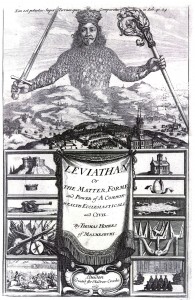The graphic novel adaptation of Paul Auster’s City of Glass by Paul Karasik and David Mazzucchelli illustrates each significance voice with a distinct font. The typewriter font is used for the narrator to indicate the final draft of the narrative as the typewriter is an instrument that once marks the page, cannot be erased. If one makes a mistake, the entire page is to be re-typed which communicates the quality of professionalism and officially of the narrator’s words. The typewriter font is used to convey the authenticity of the narrative and the authority the narrator has in the novel.
Peter Stillman Sr.’s words are embellished with a capital letter of a calligraphy style as he is a member of the upper class and well educated. The ornamental letter describes his profession as a former professor who is wealthy and was respected. The capital letter that begins his speech bubbles are written in this style as his words are carefully chosen as his is a professor concerned with languages, specifically the language of God. As a professor, Peter Stillman Sr.’s words are intellectual with a higher understanding od the words that he uses, in comparison with the layman and the capital letter indicates his knowledge.
Peter Stillman Jr.’s speech bubbles originate from within to represent that his thoughts and words are different from the other characters. There are lowercase letters in his speech as a result of the abuse and neglect that he had experienced as a child. The trauma from his father’s experiments has changed his speech patterns as the different font indicated that his language skills originate from an abnormal processing method.
Virginia Stillman’s voice on the phone is captioned with un-bolded and several lowercase letters. The lines of the words are also not straight as the telephone distorts the words of the speaker and do not truly reflect the voice of the caller. The lowercase letters indicate uncertainty of the legitimacy of her concern and the ability of the investigator that she is calling. The lower case letters and wavy composition of the works from her voice through the telephone communicates the process of sound waves converting to pressure in the air. The different frequencies of each sound are also depicted by the fluctuating appearance of Mrs. Stillman’s words.
A different font is used to signify the diverse characteristics of each character in the graphic novel adaptation of Paul Auster’s City of Glass for metaphorical and atheistic purposes.

